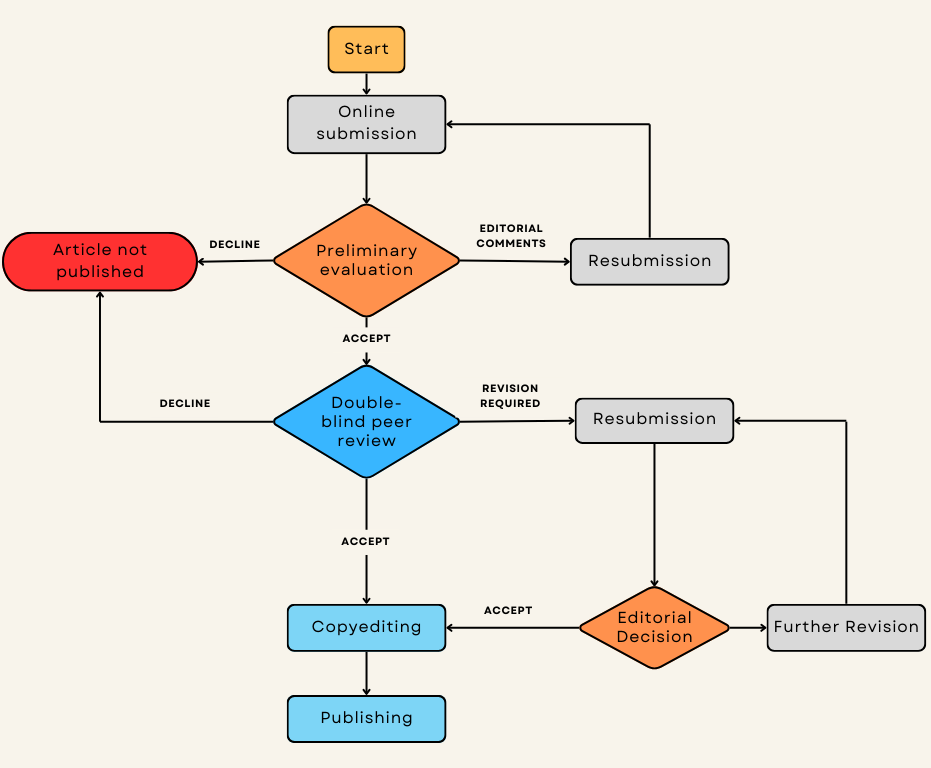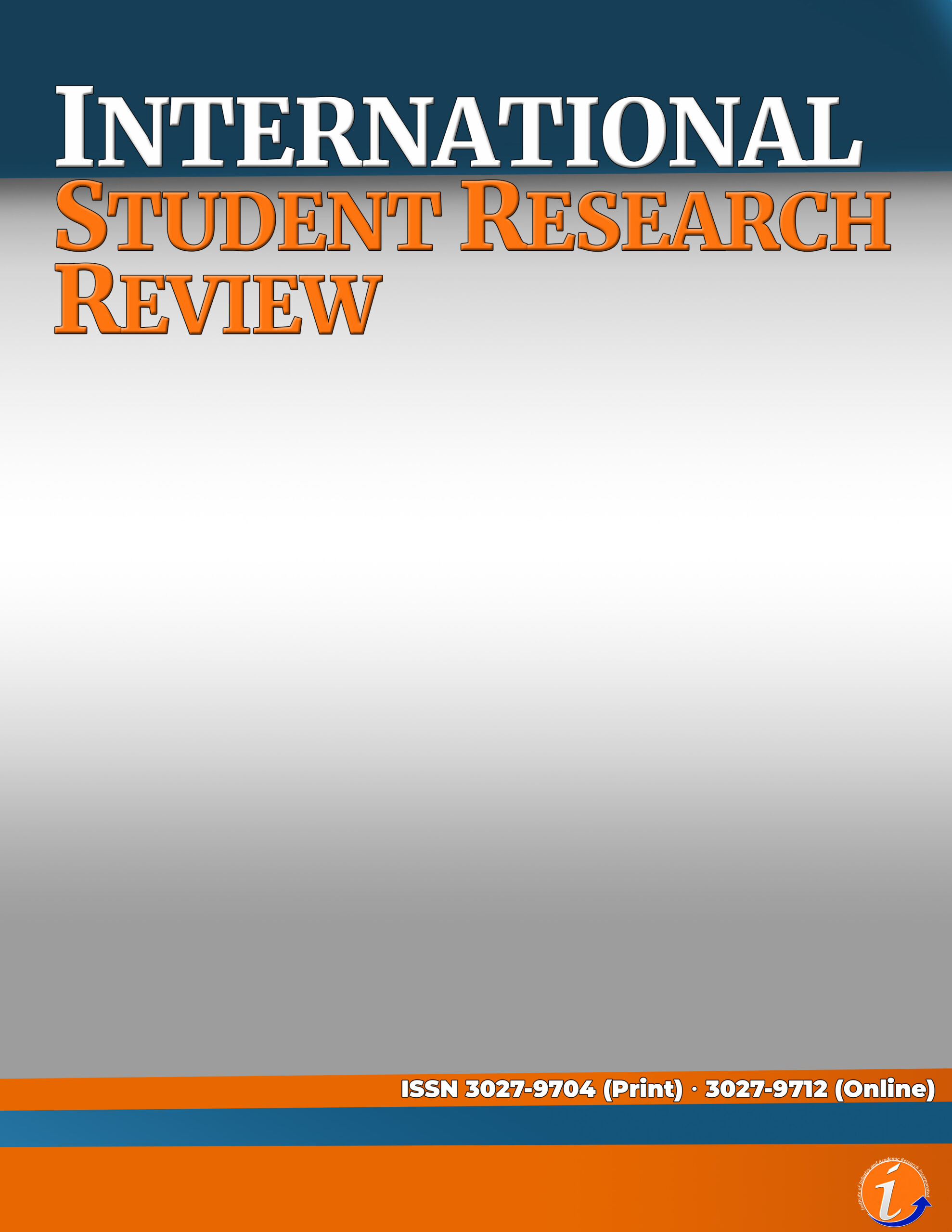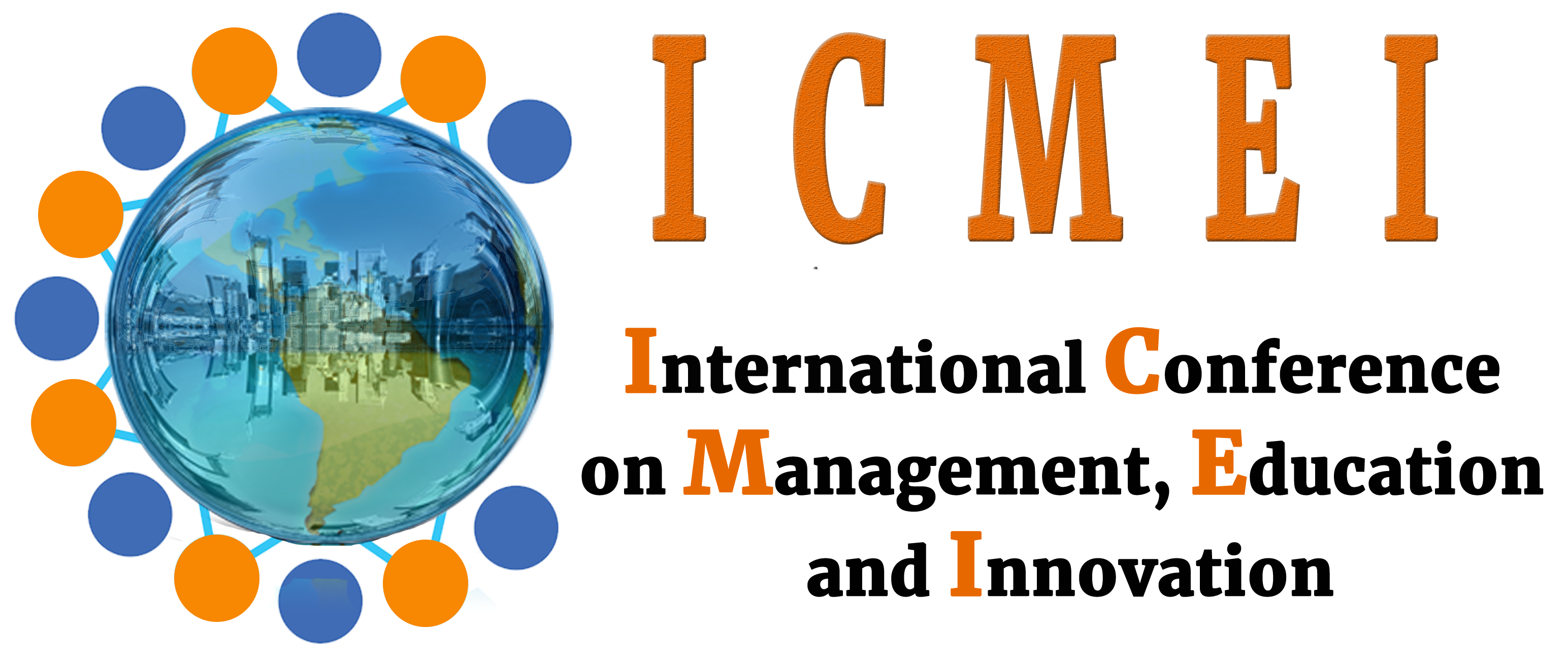
Publication Process
The files must be uploaded only through the online submission portal (click here). Your paper will be assigned Submission ID Number, which you will use for all the communications related to the publication. Upon submission, you will receive submission confirmation acknowledgement approximately within 24 hours. If the editor found your paper not within the journal scope or not within the prescribed format, your submission may receive an early manuscript rejection decision. No submission will be entertained through email.
The publication process and timeline is shown below:
|
Process |
Description |
Timeline |
|
Online submission |
The author submits the research article through the online submission portal. | |
|
Preliminary evaluation |
The journal manager and/or editor-in-chief evaluate the paper as to its fitness to the journal, formatting requirements and readiness for publication. |
1 - 2 days |
|
Double-blind review |
Upon acceptance by the journal manager and/or editor-in-chief, the anonymous manuscript is sent to potential reviewers based on specialization and expertise. The reviewers are given three weeks for the acceptance of the review assignment and review proper. |
3 weeks |
|
Revision & Resubmission |
Upon receipt of at least two most appropriate reviews, the comments of the reviewers are sent to the corresponding author through email. The author revises the paper according to the suggestions given. The resubmission must highlight in color the changes done within the revised paper and provide a matrix of action taken in addressing the reviewer comments. The revised paper must be uploaded in the same submission section as 'revision' file. |
2 weeks with extension as per author request |
|
Publication acceptance |
The journal manager and/or editor-in-chief evaluate the paper as to its readiness for publication. They proofread the paper as per the comments given by the reviewers. |
2 - 4 days |
|
Copyediting & Formatting |
The paper is sent to the copyeditor for final formatting. At this stage, the author may still need to address some reviewer comments not properly followed and/or missing required parts such as declarations and acknowledgment sections. The copyeditor ensures that the paper is structurally fit for international journal publication. |
1 week |
|
Article Publication |
The final draft copy of the paper is sent to the author for confirmation. If the author finds necessary corrections, it should be communicated to the editorial assistant through email. The open access publishing agreement is signed upon confirmation of the final copy of the article. |
You can download the step-by-step process of article submission and resubmission here.
Publication Schedule
This journal publishes an annual issue concurrent with the staging of the International Student Research Congress (ISRC).
Article Processing Charges (APC)
This journal has NO Article Processing Charge (APC). However, the paper must have been presented in the International Student Research Congress (ISRC), which charges specific conference registration fees.
Manuscript Submission Overview
Checklist Before Submission
Upon submission of the manuscript, the author warrants the following:
- The paper has been accepted and presented in the International Student Research Congress.
- The article is an original work and has not been published nor currently considered for publication elsewhere.
- The author informs all co-authors related to any agreements with respect to the article publication. The submission of which is consensus.
- The author discloses all information related to the research funding and support, and any conflict of interest are also disclosed.
- The author has obtained permission for any used materials contained in the article.
- The author confirms, to the best of his knowledge, the authenticity and integrity of the data gathered. There were no fabricated and misrepresented information and data contained in the article.
- The author follows the prescribed manuscript format, including, but not limited to, the required declarations and acknowledgement sections.
Article Type
This journal accepts any article within its scope and coverage, which may include original research, literature review/ review articles, or case studies. The submitted article needs to have strong empirical evidence and makes significant contribution to the field. It should have strong theoretical and/or methodological literature. The submission is an original article, not have been nor considered for publishing elsewhere. The author must obtain permission for any used copyrighted materials within the article.
This journal only accepts articles in English. It is the prime responsibility of the author to ensure that the paper’s quality is highly acceptable as to use of language, grammar and punctuations. The author must not use any form of hateful, discriminatory, intimidating, demeaning and inappropriate words or statements. The paper must not disparage any person or community based on gender, race, religion, or disability. The author must ensure the use of balanced discussions, providing all sides of a research problem or issue.
Manuscript Format
The online submission requires only MS Word file. There should be two files uploaded.
| FILE NUMBER | FILE TYPE | DESCRIPTION |
|---|---|---|
| 1 | Anonymous file |
This file is used for the review process. |
| 2 | Title page | This file should contain the title of the article, name and affiliation of the author/s, abstract and key words. The author must include all the appropriate acknoledgement sections. |
The manuscript must include pertinent information of the author/s including name/s, affiliation/s, address and email address. The corresponding author, in case of multiple authors, must be properly indicated.
The structure of the manuscript includes:
- Title – appropriate title to your article.
- Abstract – the number of words should not be less than 150 but not more than 250.
- Key words – a minimum of 4 to a maximum of 6 keywords.
- Main body –it should contain the following:
- Introduction
- Literature Review
- Methodology
- Results and Discussion
- Conclusion
- Acknowledgement/Any declaration
- References - at least 25 with 75% from the latest 5 years
While the journal prescribes an article format, free format submission is also accepted. The author is allowed to follow appropriate format for the paper provided all the required contents are present.
The required total word count including references must be between 5,000 to 8,000. Authors can also submit extended abstract of 4,000 to 5,000 words.
Required declarations and acknowledgements:
Conflict of Interest. This journal recognizes the definition given by the COPE, which states that "conflicts of interest comprise those which may not be fully apparent and which may influence the judgement of author, and when revealed later, would make a reasonable reader feel misled or deceived." These may include personal, commercial, political, academic or financial. The author needs to declare any relevant conflict of interest that might have affected the results of the study. For example, any monetary gains received from commissioned research, political influence or support from the subjects of the study or the potential bias on the analysis of studies involving own institution due to leadership influence. If there no conflict of interest, author uses the general statement "No potential conflict of interest was reported by the author(s)".
Authorship. This journal recognizes the definition given by COPE, which states that "authorship can refer to individuals or groups that create an idea or develop the publication that disseminates that intellectual or creative work." Accordingly, the "award of authorship should balance intellectual contributions to the conception, design, analysis and writing of the study against the collection of data and other routine work. If there is no task that can reasonably be attributed to a particular individual, then that individual should not be credited with authorship." For papers with five authors and more, mention the contributions of each author. As per the International Committee of Medical Journal Editors (ICMJE), authorship criteria include: acquisition, analysis, or interpretation of data for the work; drafting the work or revising it critically for important intellectual content; provide approval for publication of the content; and agree to be accountable for all aspects of the work in ensuring that questions related to the accuracy or integrity of any part of the work are appropriately investigated and resolved.
For example: Author 1 and Author 2 conceptualized and finalized the research framework. Author 3 and Author 4 drafted and revised the manuscript. Author 5 and Author 6 gathered, analyzed and interpreted the data. All authors contributed to the writing of the final version of the manuscript.
For papers with less than five authors, the authors can declare equal contribution or provide the authors' individual contribution. Authors can use the statement: “All authors equally contributed to the conception, design, preparation, data gathering and analysis, and writing of the manuscript. All authors read and approved the final manuscript.”
Research involving human subjects. This journal follows the general principles, as appropriate, of the World Medical Association Declaration of Helsinki (1964) Ethical Principles for Medical Research Involving Human Participants, including research using identifiable human material or data. Citing the relevant provisions, this journal recognizes that researchers need to "protect the life, health, dignity, integrity, autonomy, privacy, and confidentiality of personal information of research participants." and "consider the ethical, legal and regulatory norms and standards for research involving human participants in the country or countries in which the research originated and where it is to be performed, as well as applicable international norms and standards." The data gathering strategies that may involve human subjects include survey, interview, focus group discussion, clinical studies, experiments and observations.
This journal requires full disclosure and discussion of the following:
Informed consent discussion. The author must provide a discussion on the consensual or voluntary participation of the human subjects. The author ensures that the research aims and objectives were clearly communicated to the participants prior to the data gathering.
Participants safety and welfare. The author must provide a discussion on how the data gathering process addressed the safety and welfare of the participants. There must be discussions of the proper protocol on handling survey, interview or observation of vulnerable participants or group in the community.
Confidentiality and Data Protection. The author must follow and provide a discussion on the existing Data Protection Law in the country where the research was conducted.
Evaluation & Review of Articles
The journal adheres to the double blind peer-review process. Neither the author nor the reviewers know each other’s identity. Hence, the author needs to submit two separate files for anonymous manuscript and title page.
Any submission goes for two evaluation and review process: a) preliminary evaluation by the journal manager or editor-in-chief and b) peer review. The journal manager or editor-in-chief evaluates the paper based on its fitness to journal scope, structural requirements and readiness for publication while the reviewers give detailed comments on the paper based on the evaluation criteria. All submitted papers duly accepted for suitability to journal scope and structural requirements are sent to the potential reviewers. The journal editorial staff reserves the right to choose the appropriate reviewer based on their knowledge of the topic. Thereafter, the anonymous manuscript is sent only to those who agreed to accept the review invite.
Reviewers evaluate the following areas of the paper: introduction, literature review, methodology, results and discussion, and conclusion. While the reviewers are given the guide questions in doing the review, they are given maximum freedom to evaluate the quality of the paper. The result of the review may be any of the following: accept submission, revision required, resubmit for review, submit elsewhere and decline submission. The editor makes the decision after the receipt of at least two reviews. The decision of the editor is communicated to the corresponding author through email.
Accept submission. The paper is accepted for publication and will be sent to copyediting stage. The author signs the open access agreement form.
Revision required. Any accepted article with minor or major revisions is sent back to the author for corrections. The author is given ample time to comply depending on the severity of the corrections. If the time given is insufficient, the author is advised to formally request extension through email. During the submission of the revision file, the author uploads three files through the online submission portal: 1) anonymous manuscript; 2) title page and 3) matrix of action taken form for final evaluation by the journal manager. If the paper requires further revision, the journal manager provides further revisions request through email or through discussion forum in the portal. If the article is accepted, the author is advised to complete the open access publishing agreement.
Resubmit for review. The comments and suggestions of the reviewers are sent to the author for compliance. The author is given ample time to comply depending on the severity of the corrections. If the time given is insufficient, the author is advised to formally request extension through email. The author then submits the corrected article for another round of review.
Submit elsewhere. The paper is not considered for publication in the journal and will advise the author to consider another journal.
Decline submission. The paper is rejected for publication in the journal.
Guidelines for Reviewers
Selection of Reviewers
Recruitment of reviewers. The journal recruits experts in the field to assist the editor in the evaluation and acceptance of papers. They are selected based on their qualification and specialization. All reviewers must register through the OJS/PKP submission portal. Upon registration, interested potential reviewers check "Yes, I would like to be contacted with requests to review submissions to this journal" option to receive review assignments. All recognized reviewers receive certificate of recognition.
Selection of reviewers for an article. All editorial board and reviewers must sign up to the online submission portal. This facilitates the submission, review and acceptance of all papers. All the external reviewers are considered for the review of any article based on their expertise. The editorial assistant randomly selects reviewers based on their specialization and research interests.
Acceptance of the review. Selected reviewers can either accept or reject any invitation for review. The reviewers are given maximum of one week to accept the review task. The review itself is within a period of three weeks. Any reviewer can also ignore the invite if he/she is not confident to accept the task.
Review Process
Any submission goes for two evaluation and review process: a) preliminary evaluation by the journal manager or editor-in-chief and b) peer review. The journal manager or editor-in-chief evaluates the paper based on its fitness to journal scope, structural requirements and readiness for publication while the reviewers give detailed comments on the paper based on the evaluation criteria.
All submitted papers duly accepted for suitability to journal scope and structural requirements are sent to the potential reviewers. The journal editorial staff reserves the right to choose the appropriate reviewer based on their knowledge of the topic. Thereafter, the anonymous manuscript is sent only to those who agreed to accept the review invite.
The entire review process takes minimum one week to maximum three weeks. However, it is highly dependent on various uncontrollable circumstances. The journal ensures adherence to the proper timeline which completes the submission to final publication acceptance within the maximum 45 days.
The journal uses the OJS-PKP platform and workflow for the submission and review of articles. For guidance and assistance on the use of the portal, you can download the workflow guidelines here.
Review Results
Reviewers evaluate the following areas of the paper: originality, research background, literature review, methodology, results and discussion, conclusion and communication. While the reviewers are given the guide questions in doing the review, they are given maximum freedom to evaluate the quality of the paper.
The result of the review may be any of the following: accept submission, revision required, resubmit for review, submit elsewhere and decline submission. The editor makes the decision after the receipt of at least two reviews. The decision of the editor is communicated to the corresponding author through email.
Accept submission. The paper is accepted for publication and will be sent to copyediting stage. The author pays the publication fee and signs the open access agreement form.
Revision required. Any accepted article with minor or major revisions is sent back to the author for corrections. The author is given ample time to comply depending on the severity of the corrections. If the time given is insufficient, the author is advised to formally request extension through email. The author then submits the corrected article for final evaluation by the journal manager. If the paper requires further revision, the journal manager provides further revisions request through email or through discussion forum in the portal. If the article is accepted, the author is advised to pay the fees prior to the publication. The open access publishing agreement is then signed.
Resubmit for review. The comments and suggestions of the reviewers are sent to the author for compliance. The author is given ample time to comply depending on the severity of the corrections. If the time given is insufficient, the author is advised to formally request extension through email. The author then submits the corrected article for another round of review.
Submit elsewhere. The paper is not considered for publication in the journal and will advise the author to consider another journal.
Decline submission. The paper is rejected for publication in the journal.
The entire review process takes minimum one week to maximum three weeks. However, it is highly dependent on various uncontrollable circumstances. The journal ensures adherence to the proper timeline which completes the submission to final publication acceptance within the maximum 45 days.
The decision of the editor is communicated to the corresponding author through email. The feedback is sent to the author upon receipt of at least two reviews.
Editorial Code of Conduct
Editorial Independence. The editorial board has the sole right to accept and/or reject articles for publication without interference from the publisher and/or external bodies. However, the board must ensure that decisions are impartial and free from any bias, following the journal standards on quality publication.
Conflict of Interest. Any conflict of interest in the conduct of any review must be formally declared. Using the OJS/PKP submission portal, the reviewer must declare any potential conflict of interest by checking "I may have competing interest." Following the guidelines set by COPE, conflict of interest may arise from personal, financial, intellectual, professional, political or religious influences.
Ethical Use of Artificial Intelligence (AI) in Review Process. The journal recognizes the ethical use of Artificial Intelligence (AI) in the conduct of review. While the use of AI has valuable contribution to the reviewer on proper evaluation of the paper quality and writing the review report, the reviewer needs to maintain his/her integrity and the safety of the author manuscript. Hence, the reviewer needs to limit the use of AI as a tool to gather relevant assistance on the proper conduct of review. The reviewer must NOT upload any part of the manuscript in any AI tool to perform the review and must refrain from the deliberate use of AI in writing the review report. The use of any AI tool in grammar checking, proofreading and editing of the review report is acceptable.
Confidentiality. The journal editors and reviewers must treat all submissions with strict confidentiality. Hence, they should not reveal any details of a manuscript or the review results during and after the peer review process, other than those contents published in the journal. Similarly, they should not use any part of the manuscript for personal gain or advantage. Any certificate of merit received by the reviewer for the conduct of review can be uploaded and posted in any portal, websites or social media provided there is no disclosure of any details of the manuscript.
Timeliness. The editors and reviewers must take actions on review assignments in a timely manner. They must ensure that any issue related to the publication process is acted upon promptly.
Benefits of Becoming a Reviewer
Editorial board and reviewer roles are on a voluntary basis. As such, no monetary compensation is given for the services. However, there are non-financial and other financial incentives including:
a. Free publication. Editorial board members and reviewers are granted one free publication in any journal after the conduct of five (5) quality reviews.
b. Certificate. All recognized editorial board and reviewers receive a certificate of recognition.
c. Outstanding Reviewer of the Year. All reviewers are eligible for the annual Outstanding Reviewer of the Year award. Details of the award can be found here.
Business Model
Our Business Model
IIARI publishes open-access articles with Article Processing Charge (APC) and prints full copies of the journals through Print-on-Demand scheme. Depending on the type of publication, the institute charges specific fee inclusive of review and language editing, lay-outing and copyediting. As a non-stock, non-profit organization, the institute sustains its operation, activities, international events and competitions through the fees collected from the clients.
Publishing Revenues
Our main revenue comes from:
Article Processing Charge. We charge specific amount for publishing articles in the journal. The open-access articles with DOI are readily available online in pdf format and indexed in DOAJ, among others. All full journal issues are available through Google Books.
Sale of Printed Journals. We sell printed journals on a Print-on-Demand scheme.
Library subscription. We are open for library subscription and membership for a fee.
Post-publication Guidelines
Issuance of certificate of publication
Published authors receive the Certificate of Publication. Corresponding authors receive e-Certificate of Publication from the editorial assistant as soon as the paper is published online subject to the completion of the open access agreement form. All communications and release of e-certificates are through the corresponding author's email address.
Appeal, compalints & corrections
This journal systematically handles issues and concerns related to author appeal, complaints and corrections. All appeal, complaints and corrections related to publication must be lodged through email to any journal manager or the journal editor-in-chief. On the other hand, any ethical complaints related to any editorial staff must be communicated directly to the publisher through the president (president@iiari.org).
Review results, comments and suggestions. Any author whose article has been rejected is given the right to appeal the decision. While the journal ensures that reasons for rejection and the necessary improvements required were communicated to the author upon sending the decision, the author is given every right to seek clarification. The appeal must be submitted through an email to the journal manager or the editor-in-chief. The author needs to explain the reasons for the wrong decision. The editorial board forms a three-member ad hoc committee to evaluate the merits of the appeal. The decision of the committee shall be final and executory, which should be communicated to the author.
Correction and retraction. This journal ensures that the author receives any manuscript proof for confirmation, verification and approval before any publication. Any corrections before the publication must be communicated through email to the copyeditor. If errors are found after the publication, the author needs to communicate any required corrections through email to the journal editorial assistant, manager or editor-in-chief. Errors related to contents and grammar are corrected through in-line correction or erratum. However, any material corrections arising from plagiarism, misstatement and falsification of data or any other form of academic dishonesty would lead to the retraction of the article.
Retraction of any article shall be dealt with systematically by the journal manager and editor-in-chief. The author must be given sufficient time to respond to the concern and provided recommendations to correct any material errors in the published manuscript. Any material corrections done with the article must be treated as erratum. If the author was not able to comply with all the required corrections, the article will be retracted. All decisions must be communicated through email.
Editorial concerns. This journal upholds the highest publication ethical standards in the performance of any editorial tasks. If an author found unbecoming behavior of any of the journal editors, the complaint must be communicated through email to the publisher through the president (president@iiari.org) in the first instance. Misbehavior includes, but not limited to: asking for bribe for the acceptance of the paper; discrimnation, harassment, intimidation, or demeaning comments; and hateful verbal or written comments related to gender, race, religion, or disability.











